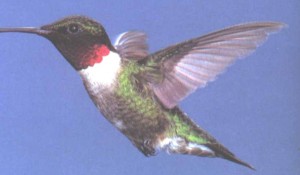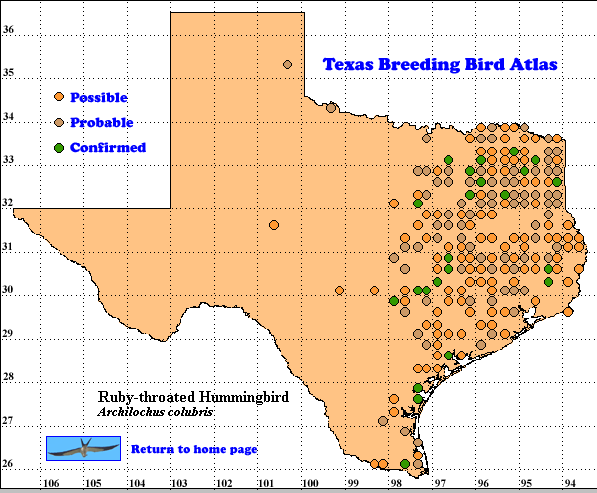Ruby-throated Hummingbirds are the only hummingbirds breeding regularly in eastern North America, outside Texas and Oklahoma. The range of this hummingbird overlaps in Texas with that of its western counterpart, the Black-chinned Hummingbird (A. alexandri) between the 97th and 98th meridians (TBBA data) and in Comanche and Stephens counties in Oklahoma (Gerard 2004, Patti 2004). The range of Buff-bellied Hummingbird overlaps that of Ruby-throated Hummingbird along the central and southern Texas coast.
The annual migration of Ruby-throated Hummingbirds needs much more study. Some individuals are known to fly nonstop over the Gulf of Mexico from the southeastern United States to Mexico and Central America, while others follow th Gulf Coast south to reach their wintering grounds (Robinson et al. 1996).
DISTRIBUTION. During the 1987-1992 field work seasons of the TBBA project, observers found almost all breeding sites for Ruby-throated Hummingbirds east of or just west of the 98th meridian. This area includes all of the Pineywoods, most of the Coastal Prairies, the eastern edge of the Post Oak Savannah and Blackland Prairie and fringes of the South Texas Brush Country and Coastal Sand Plain regions (see the region map in Lockwood and Freeman [2004]). The North American North American Breeding Bird Survey (BBS) map (Sauer et al. 2007) is similar to the TBBA map. The BBS map shows relative abundances of this species in Texas average below 3 per route, although the Town Bluff route in Jasper County had the highest average for the survey at 20.5 Ruby-throats per year (Price et al. 1995).
Elsewhere in North America most breeding occurs east of the 100th meridian from southern Canada to the Gulf Coast. Breeding also takes place in southwest Canada from Manitoba to Alberta. Most Ruby-throats winter in southwest and south Mexico and south to western Costa Rica. Some also winter in south Florida and the Florida Keys (Howell and Webb 1995, Robinson et al. 1996, Sauer et al. 2007).
SEASONAL OCCURRENCE. Most Ruby-throated Hummingbirds arrive in Texas between mid-March and mid-May and breed from early April to early September, based on egg dates from April 14 to June 22 and young fed as late as September 1. These birds depart for their wintering grounds from late July to mid-November. Migrants are common to abundant through the breeding range, with abundance decreasing westward (Oberholser 1974, Lockwood and Freeman 2004).
BREEDING HABITAT. In Texas most Ruby-throated Hummingbirds breed from near sea level to 700 m (2300 ft) in open coniferous or mixed woodlands, meadows with scattered flowering vegetation and towns and suburbs with flowering shrubs such as honeysuckle or lantana or feeders (Oberholser 1974), In Oklahoma where the abundance of this hummingbird is higher than in Texas, the atlasers,mentioned deciduous or mixed woodlands with nearby water, open areas, meadows, orchards, old fields and parks and gardens with nectar, spiders and insects (Gerard 2004).
The female, after fertilization by a male, selects the nest site, most commonly on a tree or shrub branch, 3-6 m (10-20 ft) above ground and shaded by leafy branches. The neat nest, built in about 5 days by the female, is constructed of plant down and bud scales, held together with spider silk and decorated with lichens. It looks from below like a lichen-covered knot on a branch. The outside diameter is 4.5-5 cm (1.8-2 in), height 4 cm (1.6 in), inside diameter and cup depth 2.5-3 cm (1-1.2 in; Harrison 1979, Robinson et al. 1996).
In this cup the female lays 2 smooth, white, unmarked, jellybean-sized eggs. Incubation by the female starts immediately after the first egg is laid and lasts 12-14 days in southern states. The eggs hatch 1-3 days apart and the young birds leave the nest 18-22 days later. Second successful broods in the same season are common in southeastern states. One female was reported feeding a young bird in one nest while incubating eggs in another nest 1 m (3-4 ft) away. Young birds leave the nest about 50% above usual adult weight (Harrison 1979, Robinson et al. 1996)
STATUS.Ruby-throated Hummingbirds are common summer residents within their breeding range in Texas (Lockwood and Freeman 2004). The map in Oberholser (1974) shows many breeding and summer records as far west as the 100th meridian, 2 degrees of longitude west of the western breeding boundary on the TBBA nap below. BBS data from 34 routes for 1980-2006 suggest an annual population change of -2.8%. This contrasts with a trend from 30 routes of +2.2% in Oklahoma where relative abundances are higher and competition with Black-chinned Hummingbirds may be less intense (Gerard 2004, Patti 2004, Sauer et al. 2007).
Text by Robert C. Tweit (2008)
Literature cited.
Gerard, W. B. 2004. Ruby-throated Hummingbird (Archilochus colubris) In Oklahoma breeding bird atlas, pp. 200-201 (D. L. Reinking, ed.). University of Oklahoma Press, Norman.
Harrison, H. H. 1979. A field guide to western birds’ nests. Houghton Mifflin, Boston, MA.
Howell, S. N. G. and S. Webb. 1995. A guide to the birds of Mexico and northern Central America. Oxford University Press, New York.
Lockwood, M. W. and B. Freeman. 2004. The TOS handbook of Texas birds. Texas A&M University Press, College Station.
Oberholser, H. C. 1974. The bird life of Texas. University of Texas Press, Austin.
Patti, S. T. 2004. Black-chinned Hummingbird (Archilochus alexandri) In Oklahoma breeding bird atlas, pp. 202-203 (D. L. Reinking, ed.). University of Oklahoma Press, Norman.
Price, J., S. Droege, and A. Price. 1995. The summer atlas of North American birds. Academic Press, New York.
Robinson, T. R., R. R. Sargent and M. B. Sargent. 1996. Ruby-throated Hummingbird (Archilochus colubris). In The birds of North America, No. 204 (A. Poole and F. Gill, eds.). The Birds of North America, Inc., Philadelphia, PA.
Sauer, J. R., J. E. Hines, and J. Fallon. 2007. The North American breeding bird survey, results and analysis 1966-2006. Version 7.23.2007. USGS Patuxent Wildlife Research Center, Laurel MD < http://www.mbr-pwrc.usgs.gov/bbs>

